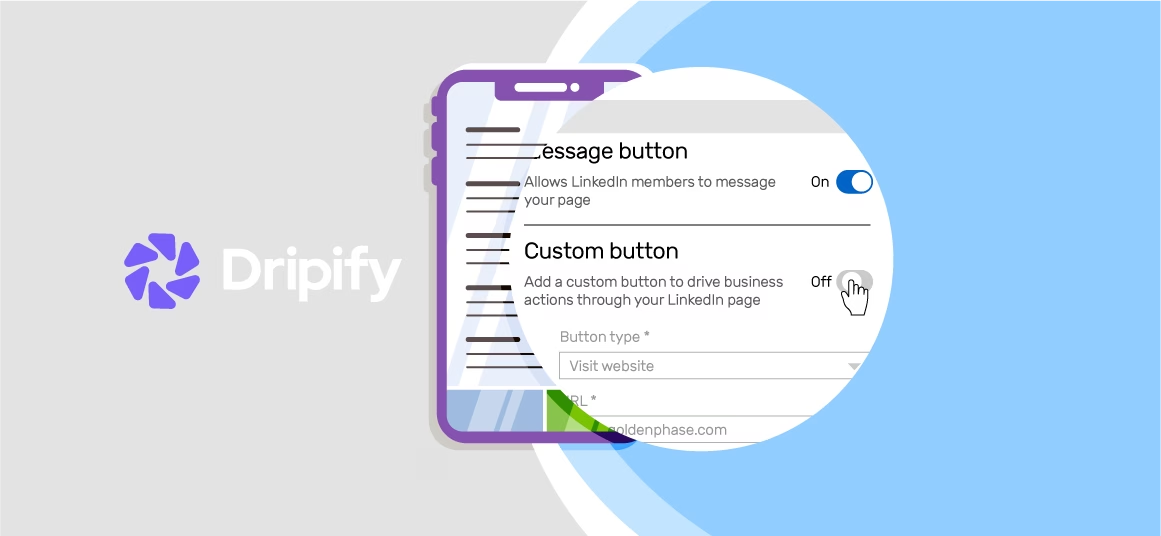| Getting your Trinity Audio player ready… |
Many B2B sales and marketing professionals confuse sales automation and marketing automation, thinking they are two different names for the same process. But the truth is that while these solutions streamline processes, increase efficiency, and drive growth, they serve different purposes and support different stages of the customer journey.
Understanding the differences between marketing automation and sales automation will help you optimize your strategy, align your teams, deploy the right tools for the right team, and close more deals.
- Sales Automation vs Marketing Automation – Key Differences
- Sales Automation
- Sales Automation Focused On
- Sales Automation Activities
- The Goal of Sales Automation
- Marketing Automation
- Marketing Focused On
- Marketing Activities
- The Goal of Marketing Automation
- Drive Your Marketing and Sales Automation with Dripify
This guide on marketing automation vs sales automation compares both solutions, so you can make informed decisions to support your goals.
Sales Automation vs Marketing Automation – Key Differences
What is the difference between sales automation and marketing automation? In the table below, we compare marketing and sales automation to answer this question.
| Aspect | Sales Automation | Marketing Automation |
|---|---|---|
| Role | Sales automation streamlines and optimizes the sales pipeline, including follow-ups, pipeline updates, and lead tracking. | Marketing automation optimizes your overall marketing campaign, including lead nurturing and content creation. |
| Primary Focus | Direct interaction with leads and closing deals. | Generating leads and nurturing large groups of prospects over time. |
| Goal | Shorten sales cycles and improve efficiency. | Generate interest in your offer and increase lead quality & conversion rates |
| Execution Time | You can start sales automation once your business is at the growth stage. | Marketing automation should ideally begin at the start of the business, irrespective of industry or growth stage. |
| Target Audience | Sales automation helps with reaching out to individual leads or accounts. | Marketing automation is meant to target large, segmented audience groups. |
| Examples of Key Activities | Follow-ups, CRM updates, and pipeline management. | Content creation and delivery, email campaigns, lead scoring, and ad targeting. |
| Users | Sales reps, SDRs, Account Executives, and sales managers. | Marketers, demand generation teams, and marketing managers. |
| Main KPIs | Deal size, conversion rates, pipeline velocity. | Lead volume, click-through rates, engagement rate, lead scoring, MQLs. |
| End results | Meetings booked and deals closed. | Qualified leads ready for sales. |
| Tools | Sales automation software like Dripify, LinkedIn automation tools, CRM, email tools, and dialers. | Best marketing automation software like HubSpot, email campaign tools, landing pages, content creation rolls, lead capture forms, lead scoring tools. |
When we compare sales and marketing automation, the most important thing to keep in mind is that sales automation improves the productivity of your sales team, whereas marketing automation helps your marketing team with lead nurturing and engagement.
Sales Automation
Sales automation removes repetitive tasks and streamlines the different stages of the sales pipeline, so your team can focus on closing deals. It improves the speed, consistency, accuracy, and overall productivity of your sales team.
Sales Automation Focused On
Sales automation is used for improving sales processes, making individual interactions faster and more consistent. It streamlines one-to-one communication between your sales team and specific leads or accounts.
Sales Automation Activities
Using Dripify sales automation software is one of the main activities here. A good software reduces manual tasks like individual outreaches, logging calls, sending follow-ups, scheduling meetings, tracking deals, or updating CRM records.
Sales automation tools come with useful features to optimize sales activities:
- Automated email drip sequences to warm up leads;
- Call reminders and auto-dialers to speed up contact;
- Triggering follow-ups based on lead behavior;
- Auto lead routing so each rep gets the right prospect;
- CRM updates that happen without manual input;
- Sending personalized outreach sequences at scale with little or no manual activity;
- Tracking email opens and link clicks to gauge interest;
- Assigning leads to reps based on rules.
The Goal of Sales Automation
The goal of sales automation is to improve the sales process, so your reps can close more deals at a faster rate. When you automate routine and repetitive tasks, your team spends less time on admin and more time selling. The best sales automation software can shorten deal cycles, improve response times, and keep your pipeline moving.
Marketing Automation
Marketing automation helps you improve your marketing team’s productivity in terms of lead generation and nurturing. It fine-tunes the processes and steps involved in attracting, engaging, and qualifying leads before they reach sales.
Marketing Focused On
Marketing automation focuses on top-of-funnel activities. It automates different aspects of your marketing process, so your team can create interest, engage your target audience, and qualify leads faster and more accurately. The idea is to come up with well-qualified leads to pass over to your sales team for further, personalized outreach.
In other words, the focus of marketing automation is on attracting and nurturing a large group of potential buyers more efficiently before they ever speak to a salesperson. You’re building awareness and trust, but you’re doing it at scale and faster.
Marketing Activities
Since marketing automation is focused on lead nurturing and lead qualification, the activities should be relevant and support its purpose.
Activities involved in marketing automation:
- Building automated email nurture streams based on user behavior;
- Creating landing pages and forms to automatically capture lead info;
- Scoring leads based on engagement (like email clicks or content downloads) with little or no manual intervention;
- Using automation tools to segment audiences for targeted campaigns based on factors like industry, job title, or intent signals;
- Running retargeting ads based on visited pages;
- Nurturing leads with personalized content;
- Using tools to track website behavior for lead scoring;
- Automating webinar or demo sign-up flows;
- Putting pop-ups and gated content on your website.
If you’re doing any of these activities in your business, it means you’re already using some form of marketing automation.
The Goal of Marketing Automation
The goal of marketing automation is to equip your marketing team with the best marketing automation tools so they can efficiently generate interest in your product or solution at scale and pass along well-qualified, interested leads to your sales team.
The best marketing automation software can streamline and optimize the activities involved in this process, so you can have a consistent supply of warm, sales-ready leads.
Drive Your Marketing and Sales Automation with Dripify
Many companies don’t synergize marketing and sales automation processes, so they end up missing out on data, speed, and efficiency. And they also skip automation tools.
Instead of the discussion about sales automation vs marketing automation try to use them both. The idea is to make them work together, even though the adoption of sales automation typically comes at the growth stage of your business. Sales automation and marketing automation should work together, not in silos. For example, when your CRM syncs with your marketing platform, your leads transition smoothly from awareness to conversation to closed deals.
You need Dripify sales automation software to support both ends of the funnel and coordinate where both processes overlap. You don’t need multiple software to automate the different activities of your sales and marketing functions because Dripify has most of the essential features built in.
Dripify is a next-gen sales automation tool that also syncs with your marketing activities.
Here’s how you can use Dripify to drive marketing and sales automation:
- Automate your LinkedIn and email outreach with personalized sequences, reach hundreds daily, and win more deals;
- Generate thousands of qualified B2B leads, each enriched with over 30 detailed data points;
- Align your messaging across sales and marketing in one centralized, user-friendly dashboard;
- Automate the full customer journey from cold lead to warm prospect to paying client;
- Track performance without jumping between platforms;
- Pull leads directly from LinkedIn to create smart, targeted, and personalized outreach;
- Find and verify the business email addresses of your prospects, improving your deliverability rate;
- Build effective email and LinkedIn drip campaigns with tailored actions, timed delays, and smart conditions to improve your outreach.
Try Dripify free trial now, to improve your sales and marketing!
Recommended For You

LinkedIn Call to Action for Lead Generation
LinkedIn has always been at the forefront of introducing new and exciting features to help businesses make the best use…
![Email Outreach Tracking [Tips, Tricks and Tools]](https://dripify.com/wp-content/uploads/2025/02/11-7-png.avif)
Email Outreach Tracking [Tips, Tricks and Tools]
Email outreach is one of the most effective and affordable marketing tools available to reach your target customers. As a…
![Create a Prospecting Plan [+8 Prospecting Methods]](https://dripify.com/wp-content/uploads/2025/02/11-png.avif)
Create a Prospecting Plan [+8 Prospecting Methods]
No matter your business, you need a steady flow of new prospects for a steady revenue stream. Prospecting is time-intensive…
Try out a smarter way to crush sales
Kickstart your sales outreach campaign today and see your first results in less than 48 hours, while enjoying your free trial
10 people or more? Get a personalized introduction to Dripify
